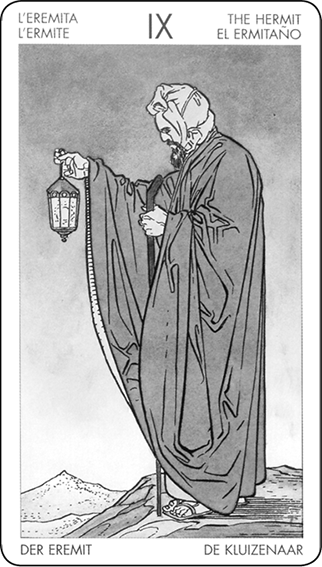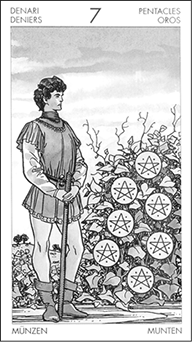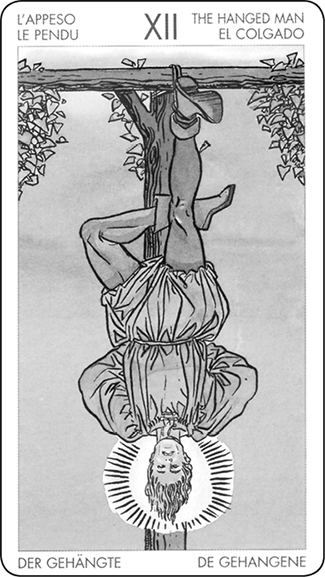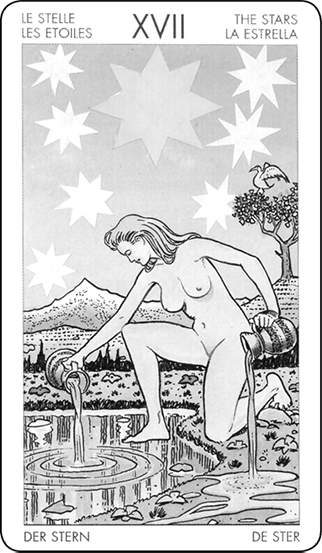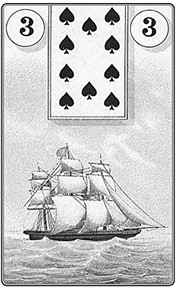Synergy
Synergy is more than a business buzzword; it’s an important concept in understanding any symbol system. Synergy is when two systems work together and the output exceeds the sum of the contribution of its individual parts.
Every symbol system relies on synergy for its meaning. Take, for example, the word “chair.” If you try to define “chair,” you will be forced to say something like “a kind of furniture on which one sits.” Leaving aside a few inadequacies in that definition, you must now define “furniture” and “to sit.” Doing so leaves us with even more terms, all of which must be defined. Finally we find ourselves having defined every single term with every other term, but without some of those terms to begin with, we’re at a loss. That might be one reason we learn the initial vocabulary of a foreign language in reference to our native language, only later graduating to dictionaries in the second language.
The reliance on synergy also holds in cartomancy. If I define one card as covering a certain territory, I must recognize that I’ve defined other cards in the process. For example, in the vast and ill-defined stew of Lenormand meanings from diverse national traditions, you can find those who define 15–Bear as money, while you’ll find others who suggest that 34–Fish is money, or 3–Ship. If we accept all these systems of meaning at the same time, we’ll have three cards with the same meaning. But if you look closely at any one system, you’ll see that each divides up the idea of “money” in different ways. For example, in the nascent American method of reading the Lenormand, I have seen 15–Bear to mean “cash flow,” and 34–Fish to mean “general wealth and liquidity.” Similarly, a traditional meaning of 35–Anchor is “job,” but many American Lenormand readers, inspired by Sylvie Steinbach’s system, prefer to use 14–Fox for “job” and 35–Anchor for “lifestyle.” At one time, our job was a permanent thing that required only our stable attention. But now jobs are mobile and rely much more upon our wits than our sinews, even among those working class jobs like construction (anyone who thinks construction workers are just grunts has probably never been on a construction job).
This shift in meaning in the Lenormand also shows that a symbol system is in a holistic synergy with the culture itself. This synergy makes sense because what is a culture but a collection of symbols? So it stands to reason that we would need to divide up our culture in new ways to fit the old Lenormand.
Similarly, with the tarot, we have taken the twenty-two major arcana cards and defined their sequence as a story that can fit our lives. The archetypes of these cards have been abstracted as a sequence of stages of development, each of which gains its meaning from not just the cards before and after it but all the cards in the deck. We can define, for example, the Empress as “the love you experience in a nurturing bond, as with one’s mother.” But doing so means that we must define the Lovers as a different stage: the exteriorization of self-love to another.
The earliest tarot decks we can find probably didn’t conceptualize the major arcana as a story in this way. I conclude this by the fact that they often didn’t have the same ordering, for one thing. Moreover, some early decks contained cards that represented important ideas in the culture—the seven virtues, for example—but didn’t sequence them as a stage of development. The “Fool’s Journey” conceptualization of the tarot is a late addition. It’s a useful late addition, however, because it recognizes the fundamental truth that each card in the tarot, like any part of a symbol system, has meaning only in relationship to the other symbols in that system, the other cards in the deck. A story is one of the easiest, most primal ways of organizing information and of showing those relationships between symbols.
Where the tarot is a story, a narrative, the Lenormand is like a map. Each of the symbols is a border surrounding some space on that map, defining possible meanings. We can classify the Lenormand cards and the ways they organize this space: some cards refer to people, some to money, some to love, some to psychological states, and some to objects. But each card stakes out a piece of the map for itself. The borders between these spaces are fuzzy, as they are in every symbol system. But at the same time, the meaning of one card does not encroach upon another. Both 36–Cross and 23–Mice are neighbors on that map of meaning. They can both indicate a state of worry, but they are different kinds of worry. 36–Cross is heavy and burdensome. 23–Mice is nervous and scurrying.
The overlap between symbols in the Lenormand is what programmers would call both a bug and a feature. If we want a chart of the universe, we would be better off with the tarot. If we try to map it in Lenormand terms, we’ll find that our universe looks a lot like the daily concerns and hopes of a bourgeois eighteenth-century French woman. As I’ve said before, we are all a lot closer to bourgeois eighteenth-century French women than we are to Renaissance scholar-monks, who wrote the allegories the tarot images are based on. So, while the tarot might be a useful map of the universe, it isn’t as likely to tell us about day-to-day things (yes, one can read the minor arcana for that, but even then—the divisions between cards are so neat, so tidy, it’s hard not to read each of them, again, as a narrative in their elemental domain).
Can we read our lives as a particular episode in the grand archetypal narrative of the universe? We can, and it is useful to do so. But we are also ordinary people with ordinary concerns. If the tarot is a calligraphy pen, a Petit Lenormand (or a deck of playing cards, or any number of other cartomancy systems) is a ballpoint. A calligraphy pen is useful for some kinds of detailed, careful work; a ballpoint is a little more appropriate for day-to-day tasks. Few people, even calligraphers, write only with calligraphy pens.
It would be easy, even tempting, to claim that the concerns of the tarot—those big sweeping archetypal events—are more important than the day-to-day events spoken of in the Lenormand. Surely, the nurturing power of nature (the Empress) is more meaningful than the love and affection spoken of in 24–Heart. But what is 24–Heart but a manifestation, a cross-section, of that great story into the narrower dimensions of our lives?
And the Lenormand cards are also archetypes: the ring is 25–Ring, an archetype of union and agreement that transcends any given ring. To say that the Lenormand does not offer us archetypes of reality is false; it offers archetypes from the perspective of a person living an ordinary life. The tarot sees these archetypes through a magic mirror; the Lenormand, through the mirror over our bathroom sink.
If this is the case, why not combine the two and use both tools to give a more complete picture of a situation? Then we could create meaning not just from the synergy between the symbols in a single deck, but we can also create synergy between the two systems to provide even more meaning.
Let’s imagine that we have a querent who is wondering about her relationship with her daughter, who is sixteen and whose friends the mother does not trust. We ask, “What does the querent need to know about her relationship with her daughter?”
We draw a tarot card, Temperance. It appears that the archetypal situation involves opposites that can become unified if tempered artfully. The querent suggest that perhaps this is her and her daughter, and that she lacks the art to temper the two: she cannot understand her daughter, and her daughter seems increasingly distant from her mother.
We ask, then, how this temperance might work out in the querent’s daily life. We draw three Lenormand cards, charging the middle position with the querent. We draw 31–Sun, 5–Tree (in the place of the querent), and 29–Lady. Interestingly, we would normally associate Lady with the querent, so we may decide that she and Tree go together: she can be a force for health in her family. What about 31–Sun? I ask the querent what she thinks.
“The sun is light, I suppose, and maybe part of the problem is I haven’t been really sharing with my daughter.”
“What does that have to do with light in your mind?”
“Well, I mean, I could shine light on my life, couldn’t I? And maybe if I told her more about me, and less about rules and such, she’d be more willing to share. It goes both ways.”
I point to Temperance.
“Yes, like that. I’ve been trying to pour her into a cup without realizing that I have to pour myself out too.”
“What about the Tree card. I see that as important.”
“I do too,” the querent says. “You say it can mean health or family, and I guess that makes sense. I see a tree in the background there in the Temperance card, and I guess young trees need care too. She’s like a young tree, standing alone. No wonder she’s trying to get friends around her. That’s just natural, I suppose, when you feel vulnerable like that tree.”
“Is that tree the only thing that’s vulnerable?”
She looks at 29–Lady. “No. I am too. That card’s me, right?”
“Usually it’s the querent, when the querent’s a woman. If it were your daughter, I’d expect 13–Child instead.”
“So it rests with me?”
“It would seem so.”
To read this way, it helps to be aware not just of the meaning of the cards but their images. As discussed earlier, many of the images on the Lenormand appear in the tarot. It also helps to use the tarot to narrow the meaning of the Lenormand. Is 14–Fox work, or cleverness? If the tarot card that accompanies it is the Fool, it’s probably the cleverness of the trickster. If it’s the Magician, it might be the sort of skills that apply to work. And if it’s Strength, it’s probably work—and hard work at that.
One tarot card is broad enough to shine light on several cards in the Lenormand deck. I’ve already described a 1:3 reading above, in which, after each of the Lenormand cards, we come back to the tarot. But we can also create different readings. For example, a layout I’ve invented that I call the shamrock reading can give an overview on a whole situation.
Lay four tarot cards, their bases together. The top card represents the intellectual or theoretical elements of the situation. The bottom card represents the emotional and unconscious elements of the situation. The card to the left is the practical and physical considerations. The card to the right is the energy that drives the situation: its origin and motivation.
Now, for each of the four tarot cards, lay out a pair of Lenormand cards. Consider the first of those cards to be the topic, and the second to be the comment. So, for example, I wish to know about a friend I haven’t seen in some time. I lay out the cards as follows.
|
|
|
|||
|
|
||||
|
|
|
|||
|
|
|
|||
|
|
|
|
||
|
|
|
|||
The intellectual situation is one of moving forward and overcoming. 12–Birds tells me that he is engaging in a lot of talk with official people: I know he wishes to get into a certain school. The indication seems to be that a lot of his mental power is bent on that task, and that it’s going well.
Emotionally, I see that he’s involved in a relationship. It’s a long-distance one, but serious enough for it to affect his life strongly. Perhaps he might even move, or she might.
The Lovers tells me that in practical terms he must make a decision, one that involves a lot of hard work and independent thought. That would make sense: the school he is trying to go to will require a lot of him.
Finally, the force that drives him lately is the Magician. He happens to be one, so this set of skills and all of these life changes are probably in accordance with his will. 22–Crossroads tell me that he must make a decision soon, and clouds mark the uncertainty of the results of that decision. But the Magician seems to assure me that he’ll juggle the situation appropriately and make a choice, even through the uncertainty. And that choice will, as the Chariot promises, get him where he wants to go.
After this reading, I had the opportunity to have dinner with my friend while attending a conference near his home city. As it turns out, he was indeed working to become accepted at a particular seminary, a decision he did not take lightly and was prompted to by carefully considered magical insight and deliberation. He also mentioned that he had met a woman who shared many of his interests, but that she lived in a different city and so they were waiting to see what the results of his application might be before making any rash decisions.
In an earlier chapter, I described a tarot procedure involving counting from particular tarot cards. We can combine this procedure with the Lenormand, laying out cards on top of the tarot cards to further refine their meaning as we count. Doing so is a dynamic process, almost as if we are divining the meaning of the tarot cards with the Lenormand cards. When we do so, we need to keep an eye on how the diverse symbol systems interact, not just on the level of what the cards mean, but also on the level of their graphic emblems. Here is where we can apply our discussion of the echoing of Lenormand symbols within the tarot: Lenormand cards that contain an image echoed in a tarot card take on added significance and also call our attention to that portion of the card.
For example, let’s return to my reading about finances earlier.
|
|
|
|
|
|
|
|
|
|
|
|
|
|
|
|
|
|
|
|
|
|
|
|
|
|
As you recall, I read the past line as follows. But now, I place a Lenormand card at each location.
|
The Lovers |
Some choices I have made … |
|
|
The Magician |
. . . involving education . . . |
|
|
Judgement |
. . . and a change in lifestyle … (viz., I was in college a very, very long time) |
|
|
Hermit |
. . . and a career in teaching and writing … |
|
|
Sun |
. . . have proven beneficial … |
|
|
Temperance |
. . . and wisely balanced. |
|
|
The Hermit, so since this is a repeat, we stop. |
||
Here we see the Lenormand giving the day-to-day interpretation of the error. Specifically, it says I was to go on a trip, but was weighed down (Anchor and Mountain). I’m fortunate to have the career I do, however, because it means that there is some hope (Stars and the tarot card the Sun). I might look to a friend skilled in money for advice.
|
The Fool |
Jumping in without double- checking … |
|
|
Death |
. . . has led to a loss due to confusion (the adjacent Moon card indicates this). |
|
|
The Devil |
There’s no way out of this mistake … |
|
|
The Empress |
. . . but overall, there’s still growth. Don’t panic (from the adjacent Hierophant). |
|
|
Death, again, so since that’s a repeat, we stop. |
||
The foolish error was certainly painful. 11–Whip reminds me a bit visually of the Fool’s bundle, which makes me think what he might have in it. Some solution to the problem, perhaps? The loss represented by Death is a nibble, rather than a full bite. It’s mice chewing away at grain, potentially destructive but not as bad as it could be. The Devil combined with 8–Coffin, however, describe the emotional content of the error, however, quite well. The Empress promises growth, and 14–Fox counsels cleverness. Don’t get trapped in the box of 8–Coffin or the chains of the Devil: think like a cunning fox. 23–Mice also reminds me that the Empress has grain at her feet: they didn’t get it all.
|
The Chariot |
My car … |
|
|
The World |
. . . can be brought full circle … |
|
|
The Star |
. . . and offer some freedom and hope. |
|
|
The Chariot, which is a repeat, so we stop. |
||
One of the problems with using actual readings for examples is that they often look contrived. Here we have a pleasant outcome: 34–Fish promises independence and freedom, similar to the Chariot (and if you’ll recall, the Chariot is associated with Cancer, certainly a sign friendly to 34–Fish). 9–Flowers promises a gift, and 15–Bear and the Star counsel hope for increased cash flow. The tarot card XVI–The Star of course points upward again to 16–Stars, the Sun in the past: what success was had in the past will be had in the future as well. It’s almost too perfect, but I promise, I’m just reporting the cards as they fell.
Synergistic reading spurs intuition because it relies on it so heavily to integrate and reconcile the different symbol systems. It also requires and helps develop mental flexibility and symbolic thinking. It can be particularly powerful with collaborative approaches to reading. The most valuable feature of synergistic reading, however, is in my opinion the way in which it pulls us back from minutia into the big picture. By moving back and forth from one type of cartomancy to another in the same reading, we’re forced to focus in on the details, then out to the big picture, several times. It’s hard to define the sense of completeness and confidence that this procedure gives a reading, so I recommend trying it yourself.

















